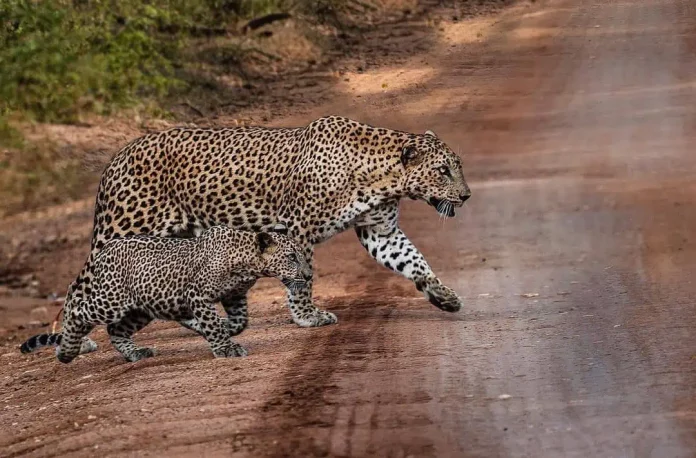There are two types of leopard species living in Sri Lanka. One species is commonly known as the Sri Lankan leopard and the other one is a very special and rare species known as the Sri Lanka Black leopard. So first, let’s talk about common species.
The leopard is the largest member of the cat family in Sri Lanka. It is a subspecies of the world’s tiger family and is native to Sri Lanka, hence their scientific name is Panthera Pardus Kotiya. They are one of the predatory mammal species found in Sri Lanka.
The Yala National Park in Sri Lanka has the largest leopard population in the world. The Wilpattu National Park in Sri Lanka is also famous for its Leopard sightings. Compared to other countries of the world, the leopards can be seen living in large numbers in different parts of the country, sharing their natural habitats with the rest of the animals.
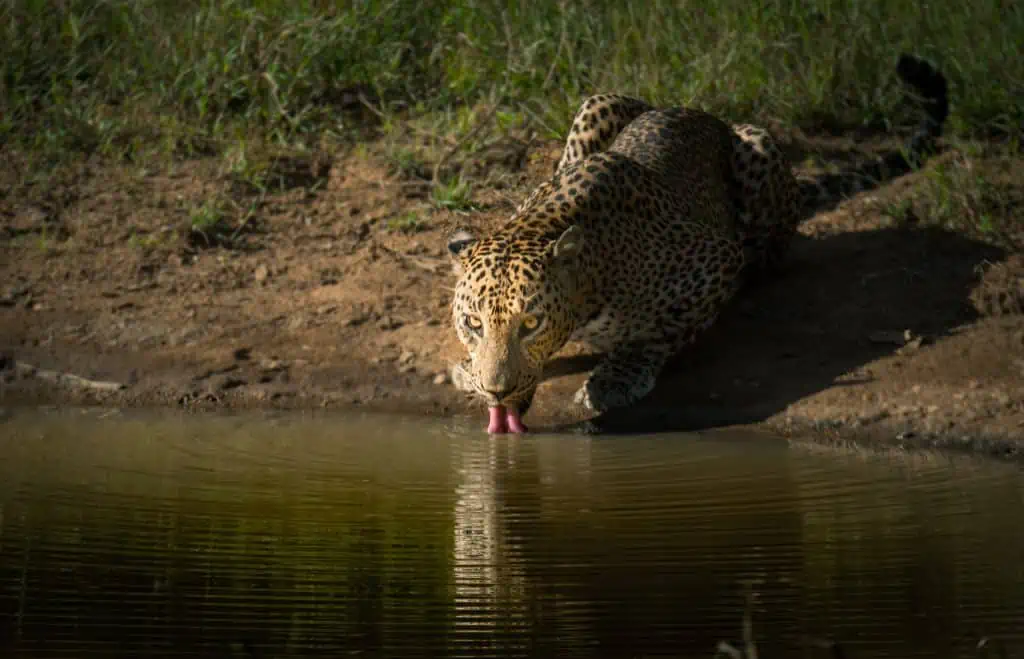
Uncovering the Secret Lives of Sri Lankan Leopard
Habitat
Leopards have a solitary living style, but females with cubs live with their offspring. A male’s territory usually overlaps the smaller territories of several females, as well as parts of the territories of adjacent males. Being more active throughout the day, they prefer to hunt at night as nocturnal.
But their activities can be seen in the morning, evening, and during the day. they like to sleep on a tree branch during hot times in the afternoon. It is common practice to rest in the shade of a forest or in the shade of a rocky outcrop during intense sun exposure. They have a good ability to climb trees and swim too.
Leopards follow a pursuit method to hunt. So they follow their prey in silence for a considerable distance until they have the opportunity to quickly pursue and unleash a rapid burst to strike. They rarely take their prey up trees due to the relative abundance of food and the lack of intraguild competition for their food in Sri Lanka. As an island nation, the Sri Lankan Leopard is the last link in Sri Lanka’s natural food chain.
This means that they have no other animals to compete with, in comparison to other countries that have larger stronger tigers and lions. leopard usually prefers to enjoy their meal alone and They have a habit of resting near their prey for a short period after killing, especially after a tiring hunt. and then they start having the meal.
Claw marks are usually staked on trees to warn trespassers into leopard territory. In addition, scent marks are also used.
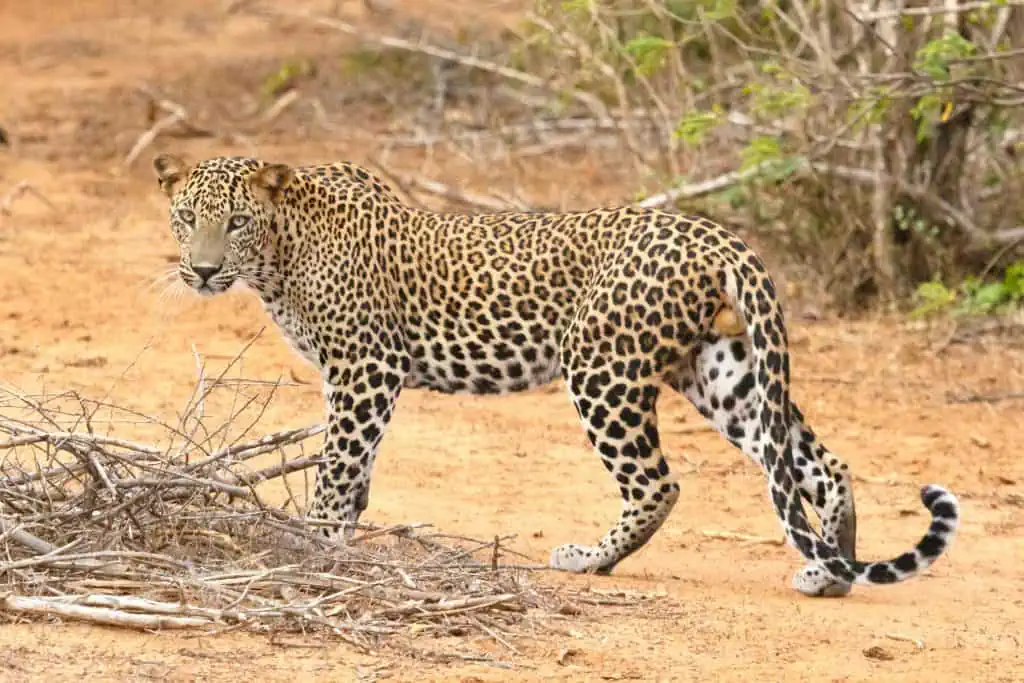
Distribution
In the past, Leopards were spread all over the island. Still can be seen sparingly in protected and unprotected areas of all habitats throughout the island but is abundant in the dry zone. Small numbers are found living in the Horton Plains National Park, Sinharaja Rain Forest, and Adam’s Peak Forest Reserve, as well as in forests, tea estates, grasslands, homesteads, and pine and eucalyptus plantations in the central hills. Most Sri Lankan Leopards live in abundance in the Wilpattu Sanctuary Which is about 60-70% of the total population
Behavior and Social Organization
like other cats, Leopards employ a single-male but multi-female social system. The size of a leopard’s territory depends on the availability of prey. A male’s home range may encompass 16-20 sq Km and a home range for 3-4 females is 2-4 sq Km. This species of cat uses scent to mark the territory. This enables them to avoid actual physical combat which may be fatal to one or both combatants.
Early in the morning or late in the evening adult leopards can be encountered walking along dirt tracks and making scents. They often spray urine upwards to the underside of leaves so that it persists longer. They will also use feces and scratch marks to announce their presence. A rival leopard is able to assess the sex and condition of another one from its scent marks.
Males guard their territories and thereby maintain exclusive access to the females within them. When a female is at the peak of receptivity to mating, The male will stay with her for several days and mate with her. It is the female that initiates courtship by flirting with the male. The male takes no part in bringing up the young after mating he parts company with the female. The young are termed cubs until the age of about six months and termed subadults until about 18 months. At this stage, They are totally dependent on the mother.
At about 18 months of age, Male cubs especially begin exploratory forays to seek a territory. at this time the males are the size of the mother and cubs are often mistaken for a pair of adults. Most daytime sightseen leopards are subadults. After about two years the males disperse and become nocturnal in habit. This is a very dangerous time for young adults as existing territory holders will fight them to the death. Males tend to push out further away from their mother’s territory, while young females carve out territory near their mother.
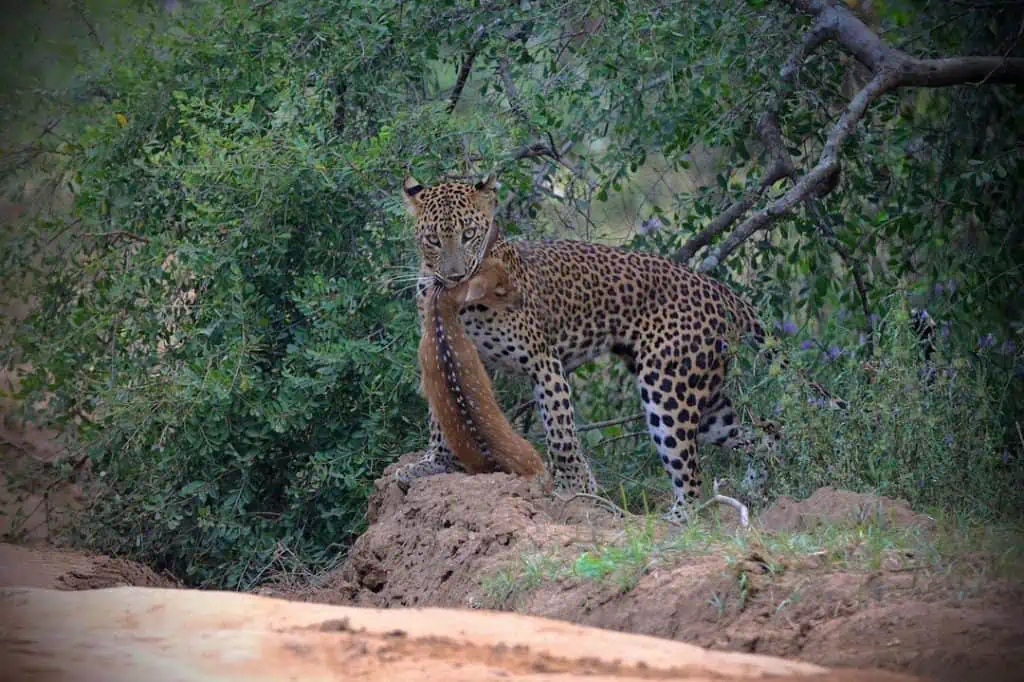
Diet
Leopards are carnivores. Like cats, they are pragmatic in choosing their diet, which can include large mammals such as deer, sambar deer, cattle, dogs, and goats as well as all small animals also be prey to leopards. Sri Lankan deer make up the majority of their diet in the dry zone. They also prey on water buffalo, Barking deer, Wild boar, and monkeys.
Reproduction and Lifespan
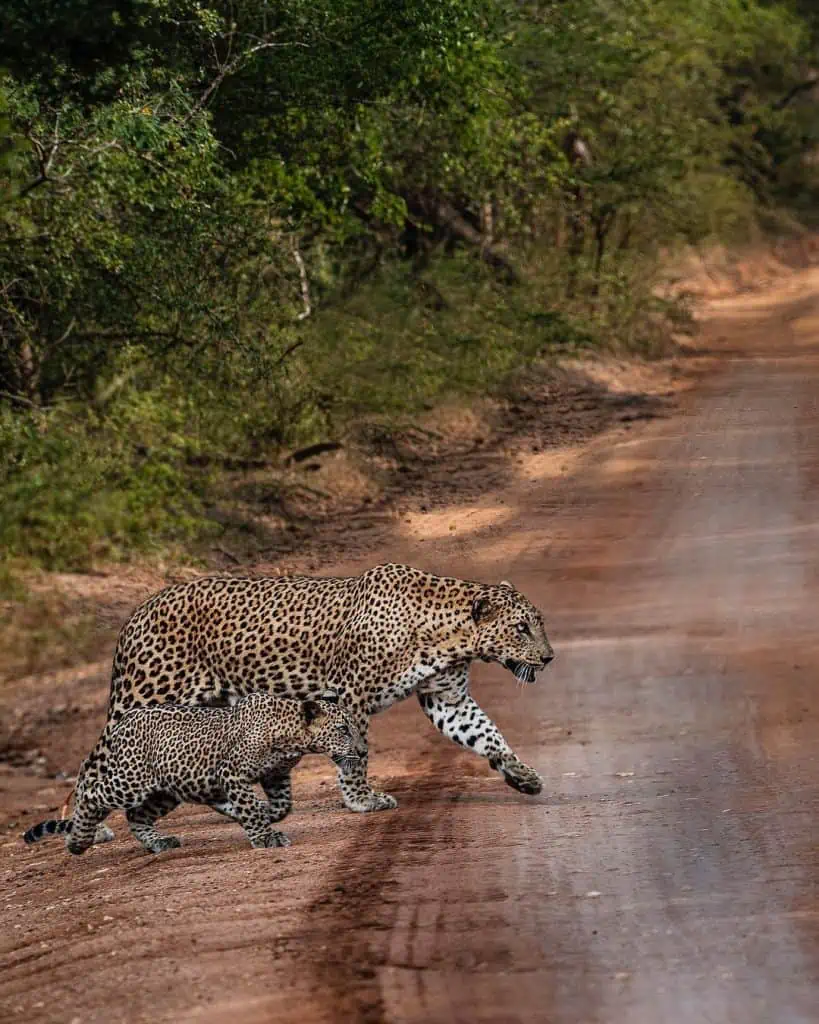
Sri Lankan leopards have a polygamous mating system, meaning that both males and females mate with more than one partner. Because of this, their breeding takes place throughout the year. The gestation period lasts 90-105 days and 2 to 4 cubs are born at a time.
Females give birth to cubs in crevices between rocks, hollow trees, etc. Cubs are born with closed eyes but open them between 4 and 9 days after birth. Being extremely vulnerable in the wild, cubs are hidden and reared in isolated places. At 3 months of age, the cubs are weaned and start hunting with the mother.
Cubs stay with their mother for 18-24 months, after which they separate from their mother to find their own territories. Young leopards become sexually mature between 2 and 3 years of age.
Leopard’s average lifespan is about 12 years in the wild and up to 22 years in captivity.
Physical features
A fully grown adult can grow to about 5 to 6 feet long with a tail and between 1.5- and 2.5 feet in height. Their weight can vary from between 30 and 90 kg. They are easily recognizable because of the presence of black spots on yellow skin with a long tail. Surprisingly, to some, the males are also usually smaller than the females.
Treats and Conservation
World Conservation Union (IUCN) has said that the Sri Lankan Leopard should be closely protected because they are already listed as an endangered species. Their endangered status is mainly due to the deforestation of their habitat and poaching for their skin and teeth. Due to their extreme adaptability, these animals are accustomed to living even near human habitations, which can be a blessing and a sin at the same time. The Sri Lanka Wildlife Conservation Department is protecting the leopards in Sri Lanka and suspending human activities that threaten their survival by making strict laws for people to adhere to.
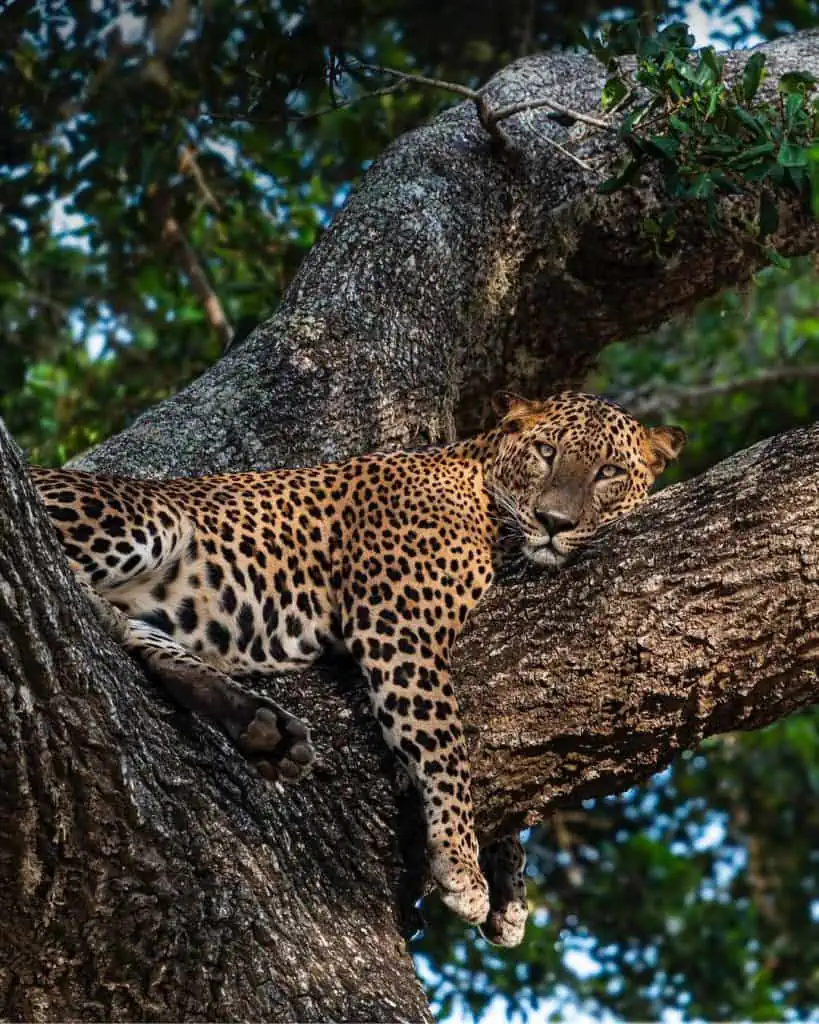
Where to see
The best places in the world to see leopards are Wilpatthu National Forest and Yala National Park. The highest population of Leopards is found in Wilpattuwa National Park and it is 60-70% at percentage. Also, the highest density of leopards in a minimum zone is found in Yala National Park. Because of this, the possibility of seeing the leopard in these parks is very high. However, rarely, leopards can be seen in national parks such as Udawalawa, Horton Plains, Bundala, etc.
Sri Lankan Black Leopard
The Leopard is one of the most common species in Sri Lanka but Black leopards are born due to the natural absence of a pigment that would normally give this species its color. The Sri Lankan Black Leopard is not another species but a sub-color variation of the Panthera Paduz Kotiya that is recorded locally.
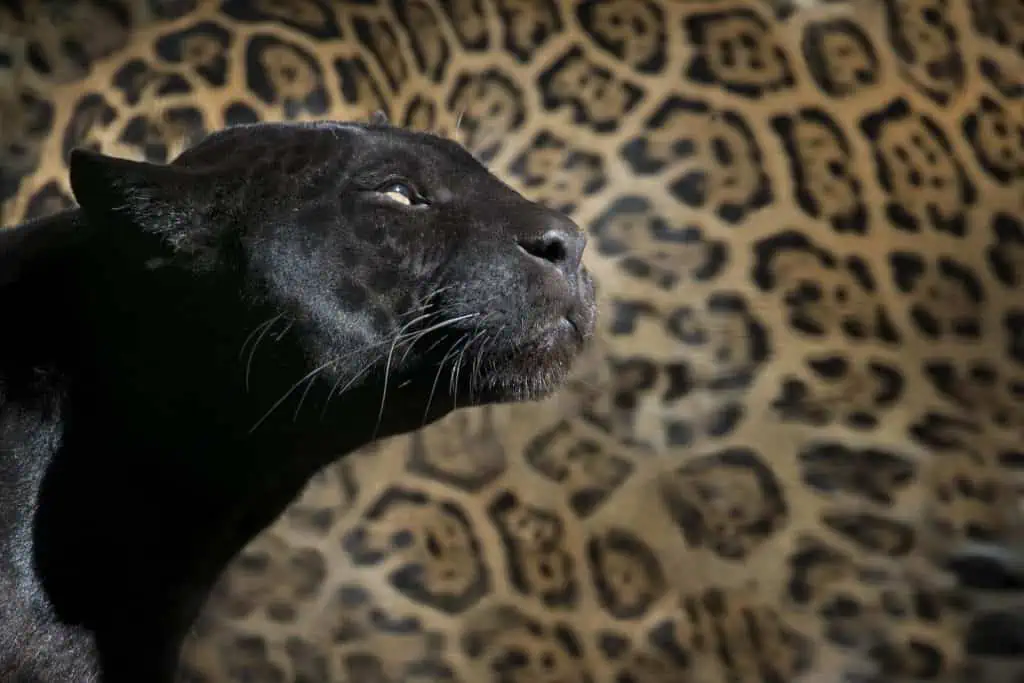
Due to the higher production of the pigment melanin in the body, the black leopards are different from common leopards. Some researchers have suggested that the color variation may be due to the darker nature of the living environment and lower temperatures. Both the Jaguars and the Leopards, which have the same adaptation, are often compared to the Black Panthers. Undoubtedly, you have noticed that they have always attracted the most attention among the leopard species in the world, probably due to the natural beauty of their color.
Several Black leopards have been reported from time to time in the forests of Sri Lanka. Although it has been reported that there may be Black Leopards in about six places in the countryside, so far only one female leopard has been found as clear evidence.
Evidence About Sri Lankan Black Leopard
Daily Mirror News
A rare black leopard captured on camera in Yala
Sirasa Tv News
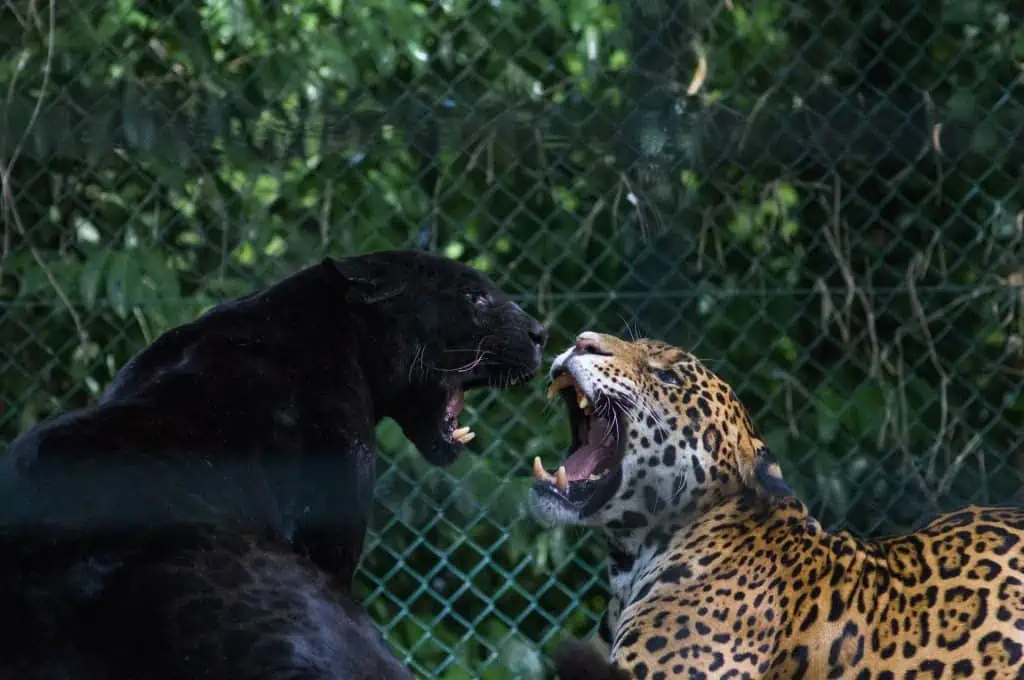
The Panthera Pardus Kotiya subspecies, which are native to Sri Lanka have only a very limited population left. The Sri Lankan Black Leopard is one of the world’s most endangered wildlife species, as its color is unique. In addition to the female, a male, and two cubs were reported to be roaming around the spot where the Black Leopard was found. Of course, it is good news for the world zoology field that the dormant gene of the Sri Lankan Black Leopard color variant remains a living gene in the leopard population, one we hope can continue to grow under protection.
Conclusion
In the heart of Sri Lanka’s wilderness, the Sri Lankan leopard remains a symbol of nature’s profound beauty and complexity. With concerted efforts, we can ensure that this elusive big cat continues to grace our planet for generations to come.
FAQs
- How is the Sri Lankan leopards different?
The Sri Lankan leopards are different from other leopards due to their distinct subspecies status, characterized by their slender build and a golden-yellow coat adorned with dark rosettes. This sets it apart from the typical leopard found in other regions.
- Are leopards in Sri Lanka endangered?
Yes, Sri Lanka leopard is considered endangered due to habitat loss and poaching, which pose significant threats to their population.
- Are Leopards in Sri Lanka the same as African leopards?
No, they are a distinct subspecies known for their slender build and golden-yellow coats adorned with dark rosettes.
- How many Leopards are left in Sri Lanka?
Estimates of the current Leopard population are varied, but it is believed that roughly 700 to 950 individuals are remaining in the wild. Conservation efforts are essential to protect this Sri Lankan Leopard species and ensure its survival.

